List of World Heritage Sites in Ukraine facts for kids
The United Nations Educational, Scientific and Cultural Organization (UNESCO) helps protect important places around the world. These places are called World Heritage Sites. They are chosen because they have special value for everyone, either for their history and culture or their amazing natural beauty. Countries that agree to the UNESCO World Heritage Convention, which started in 1972, can suggest sites.
Cultural heritage means things like old buildings, sculptures, or archaeological sites. Natural heritage includes beautiful natural areas, unique landforms, or places where rare animals and plants live. Ukraine officially joined the UNESCO Convention on October 12, 1988, even before it became an independent country in 1991.
As of 2023, Ukraine has eight World Heritage Sites. Seven of these are cultural sites, meaning they are important for history or art. One site, the Ancient and Primeval Beech Forests of the Carpathians and Other Regions of Europe, is a natural site, recognized for its unique forests.
The first site listed in Ukraine was "Kyiv: Saint-Sophia Cathedral and Related Monastic Buildings, Kyiv-Pechersk Lavra" in 1990. The newest site is the Historic Centre of Odesa, added in 2023. Sadly, this site was immediately put on the "endangered" list because of the war in Ukraine. Later in the same year, the sites in Kyiv and Lviv were also added to this endangered list.
Some of Ukraine's World Heritage Sites are shared with other countries. These are called transnational sites. For example, the Wooden Tserkvas (churches) are shared with Poland. The Struve Geodetic Arc is shared with nine other countries, and the Ancient and Primeval Beech Forests are shared with 17 countries! Besides these, Ukraine has 16 other sites that it hopes to add to the World Heritage list in the future.
Ukraine's World Heritage Sites
UNESCO uses ten different rules, or "criteria," to decide if a place can be a World Heritage Site. Each site must meet at least one of these rules. Rules i through vi are for cultural sites, and rules vii through x are for natural sites.
* Shared with other countries ![]() In danger
In danger
| Site Name | Picture | Location | Year Added | UNESCO data | What Makes it Special |
|---|---|---|---|---|---|
| Kyiv: Saint-Sophia Cathedral and Related Monastic Buildings, Kyiv-Pechersk Lavra |
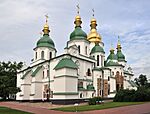 |
Kyiv | 1990 | 527ter; i, ii, iii, iv (cultural) | The Saint-Sophia Cathedral was built in the 11th century, after Christianity came to Kievan Rus'. Inside, you can still see amazing mosaics and frescos from that time. The buildings around the cathedral were added later, in the 17th and 18th centuries, in a style called Ukrainian Baroque. The Kyiv-Pechersk Lavra is a large group of monasteries that grew from the 11th to the 19th centuries. It has churches, monasteries, and caves where saints are buried. It was a very important center for the Eastern Orthodox Church. The nearby Church of the Saviour at Berestove was added to the site in 2005. In 2023, this site was put on the "endangered" list because of the war. |
| L'viv – the Ensemble of the Historic Centre |
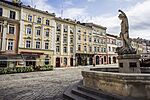 |
Lviv Oblast | 1998 | 865bis; ii, v (cultural) | The city of L'viv was founded in the late Middle Ages and still looks much like it did back then. Many different groups of people have lived here over centuries, including various Christian groups, Muslims, and Jews. This mix of cultures shaped the city. The buildings combine styles from Eastern Europe with ideas from Italy and Germany. You can see many buildings from the Renaissance and Baroque periods. In 2023, this site was put on the "endangered" list because of the war. |
| Struve Geodetic Arc* | 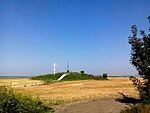 |
Khmelnytskyi Oblast, Odesa Oblast | 2005 | 1187; ii, iii, vi (cultural) | The Struve Geodetic Arc is a chain of special points used for surveying. It stretches over 2,820 kilometers (about 1,750 miles) from Norway all the way to the Black Sea. These points were set up by an astronomer named Friedrich Georg Wilhelm von Struve. He used them to accurately measure a long part of the Earth's meridian, which helped us understand the Earth's size and shape. The World Heritage Site includes 34 points in 10 countries. Four of these points are in Ukraine (one is pictured in Felshtyn). |
| Ancient and Primeval Beech Forests of the Carpathians and Other Regions of Europe* | 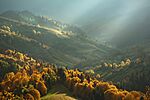 |
Ivano-Frankivsk, Khmelnytskyi, Lviv, Zakarpattia oblasts | 2007 | 1133ter; ix (natural) | This site protects untouched examples of temperate forests. These forests show how European beech trees spread across the continent after the last Ice Age, starting from a few small areas. The site was first listed in 2007, shared by Slovakia and Ukraine. It has been expanded several times and now includes forests in 18 countries. In Ukraine, 13 forest reserves are part of this site (one is pictured near Synevyr). |
| Residence of Bukovinian and Dalmatian Metropolitans | 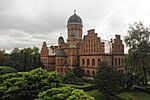 |
Chernivtsi Oblast | 2011 | 1330; ii, iii, iv (cultural) | This grand building was made for the Eastern Orthodox metropolitan bishop in the late 1800s. At that time, the region was part of Austria-Hungary. A Czech architect named Josef Hlávka designed it. The building looks historic, mixing styles like Byzantine, Gothic, and Baroque. It was the bishop's home until World War II. In 1955, it became part of Chernivtsi University. |
| Ancient City of Tauric Chersonese and its Chora | 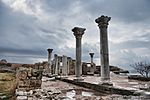 |
Sevastopol | 2013 | 1411; ii, v (cultural) | This city was founded by Dorian Greeks in the 5th century BCE (that's over 2,500 years ago!) on the coast of the Black Sea. Over time, Greek, Roman, and Byzantine people lived and interacted here. The city was finally abandoned in the 15th century. The land around the city was important for making wine, and you can still see the remains of ancient vineyards. |
| Wooden Tserkvas of the Carpathian Region in Poland and Ukraine* | 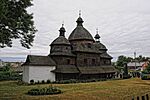 |
Ivano-Frankivsk, Lviv, Zakarpattia oblasts | 2013 | 1424; iii, iv (cultural) | This site includes 16 wooden churches, called tserkvas, in the Carpathians mountains. Eight of these churches are in Ukraine. They were built between the 16th and 19th centuries by Eastern Orthodox and Greek Catholic communities. Their designs follow Orthodox traditions but also have local influences. They feature wooden bell towers, special screens inside called iconostasis, and colorful decorations. They also have churchyards, gatehouses, and graveyards. The Holy Trinity Church in Zhovkva is one example (pictured). |
| The Historic Centre of Odesa |
 |
Odesa Oblast | 2023 | 1703; i, ii, iii, iv, v (cultural) | The city of Odesa grew very quickly as a port city in the late 1700s and 1800s. It was a city with many different cultures, including Bulgarians, Greeks, Armenians, Jews, Italians, and Ukrainians. All their traditions mixed together. Odesa still has many beautiful 19th-century buildings and areas, like Primorsky Boulevard, the Potemkin Stairs, and the Odesa Opera and Ballet Theater (pictured). This site was immediately put on the "endangered" list because of the war. |
Sites Ukraine Hopes to Add
Besides the sites already on the World Heritage list, countries can keep a "tentative list" of places they might want to nominate in the future. A site must be on this tentative list before it can be considered for the main World Heritage list. As of 2023, Ukraine has 16 sites on its tentative list.
| Site Name | Picture | Location | Year Added | UNESCO Criteria | What Makes it Special |
|---|---|---|---|---|---|
| Historic Centre of Tchernigov, 9th—13th centuries | 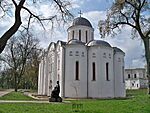 |
Chernihiv Oblast | 1989 | i, ii, iv (cultural) | This nomination includes the historic center of Tchernigov, also known as Chernihiv, which dates back to the 9th to 13th centuries. It features the Transfiguration Cathedral from the 11th century and the Borysohlibskyi Cathedral from the 12th century (pictured). |
| Cultural Landscape of Canyon in Kamenets-Podilsk | 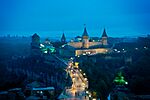 |
Khmelnytskyi Oblast | 1989 | i, ii, iv (cultural) | This nomination includes the castle (pictured) and the historic center of the city Kamianets-Podilskyi. These structures date from the 11th to the 18th centuries. |
| Tarass Shevtchenko Tomb and State Historical and Natural Museum - Reserve | 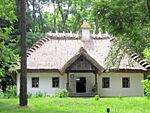 |
Cherkasy Oblast | 1989 | (mixed) | This site is dedicated to Taras Shevchenko, a famous Ukrainian poet and artist. It includes his tomb and a museum. |
| National Steppe Biosphere Reserve "Askaniya Nowa" |  |
Kherson Oblast | 1989 | x (natural) | This is a special nature reserve that protects a unique steppe (grassland) environment. It's home to many animals, including wild horses (pictured). |
| Dendrological Park "Sofijivka" | 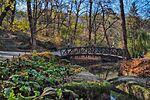 |
Cherkasy Oblast | 2000 | (mixed) | This beautiful English-style park was started in 1796. It's a great example of garden design from that time and has over two thousand different plant species. |
| Bagçesaray Palace of the Crimean Khans | 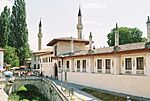 |
AR Crimea | 2003 | i, iii, v, vi (cultural) | This palace was built in the early 1500s and was the home of the Crimean Khans for about 250 years. The complex includes two mosques, official buildings, living areas, courtyards, and parks. |
| Archaeological Site "Stone Tomb" |  |
Zaporizhzhia Oblast | 2006 | iii, vi (cultural) | This archaeological site has a large mound of sandstone blocks, up to 12 meters (about 39 feet) tall. Many petroglyphs (rock carvings) are found on the stones, some from the Neolithic period and most from the Bronze Age. |
| Mykolayiv Astronomical Observatory | 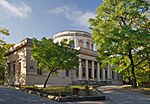 |
Mykolaiv Oblast | 2007 | ii, iv (cultural) | The observatory in Mykolaiv was founded in 1821 as a naval observatory. It includes the main building in a Classicist style, older astronomic buildings, and three modern ones still used for research. |
| Complex of the Sudak Fortress Monuments of the 6th – 16th c. |  |
AR Crimea | 2007 | ii, iv, v (cultural) | The walls of this fortress in Sudak were first built by the Byzantines in the early Middle Ages. Most of the structures you see today were built by the Genoese in the 14th and 15th centuries. The fortress became a museum in 1958. |
| Astronomical Observatories of Ukraine* | 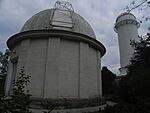 |
Mykolaiv Oblast, Kyiv, Odesa Oblast, AR Crimea | 2008 | ii, iv, vi (cultural) | This nomination includes important astronomical observatories. Four observatories from the 19th and 20th centuries in Ukraine are part of this group: Mykolaiv Observatory, the Astronomical Observatory of Kyiv National University, the Astronomical Observatory of Odesa National University, and the Crimean Astrophysical Observatory (pictured). |
| Kyiv: Saint Sophia Cathedral with Related Monastic Buildings, St. Cyril's and St. Andrew's Churches, Kyiv-Pechersk Lavra (extension of Kyiv: Saint-Sophia Cathedral and Related Monastic Buildings, Kyiv-Pechersk Lavra) | 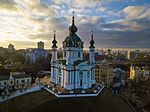 |
Kyiv | 2009 | i, ii, iii, iv (cultural) | This nomination suggests adding two more churches to the existing World Heritage Site in Kyiv. St. Cyril's Monastery is a great example of old Kievan Rus' architecture from the 12th century. St. Andrew's Church (pictured) was built in the mid-1700s by Francesco Bartolomeo Rastrelli and is a rare example of Elizabethan Baroque style in Ukraine. |
| Trading Posts and Fortifications on Genoese Trade Routes. From the Mediterranean to the Black Sea* | 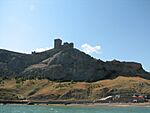 |
AR Crimea | 2010 | ii, iv (cultural) | This nomination includes important trading posts and forts built by the Republic of Genoa between the 11th and 15th centuries. These sites were part of a large trade network across the Mediterranean and Black Sea. In Ukraine, the fortress in Sudak is part of this nomination. |
| Cultural Landscape of "Cave Towns" of the Crimean Gothia | 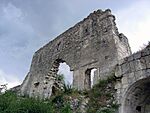 |
AR Crimea | 2012 | iii, v, vi, vii (mixed) | This nomination includes two medieval settlements of the Crimean Goths, Mangup and Eski-Kermen. It also covers the surrounding areas with limestone formations and man-made caves. The Goths settled here in the 3rd and 4th centuries. Mangup was their capital. |
| The historical surroundings of Crimean Khans' capital in Bakhchysarai | 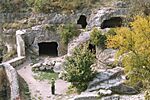 |
AR Crimea | 2012 | ii, iii, v, vi (cultural) | This nomination includes the Khan's palace and the fortress of Chufut-Kale (ruins pictured), along with their surroundings. The palace was the home of the Crimean Khans. The area around Chufut-Kale was home to the Alans and later became the first capital of the Crimean Tatars. |
| Derzhprom (the State Industry Building) | 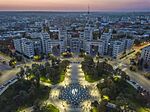 |
Kharkiv Oblast | 2017 | iv (cultural) | Derzhprom, or the State Industry Building, is in Kharkiv. Built in the 1920s, it's the world's largest building in the constructivist style. It was designed by architects S.S. Serafnnov, M.D. Feldher, and S.M. Kravets. This building helped make modernism a popular style in the Soviet Union for several years. |
| Tyras - Bilhorod (Akkerman), on the way from the Black Sea to the Baltic Sea | 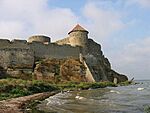 |
Odesa Oblast | 2019 | ii, iv, vi (cultural) | The ancient Greek colony of Tyras was founded in the 6th century BCE on the banks of the Dniester Estuary. For centuries, it was an important trade port, connecting routes to the Silk Road, the Baltic, and the Mediterranean. The city, now called Bilhorod-Dnistrovskyi, was shaped by many different communities over time. |
See also
 In Spanish: Anexo:Patrimonio de la Humanidad en Ucrania para niños
In Spanish: Anexo:Patrimonio de la Humanidad en Ucrania para niños
- Intangible cultural heritage of Ukraine
- List of historic reserves in Ukraine
- National parks of Ukraine
- Tourism in Ukraine

